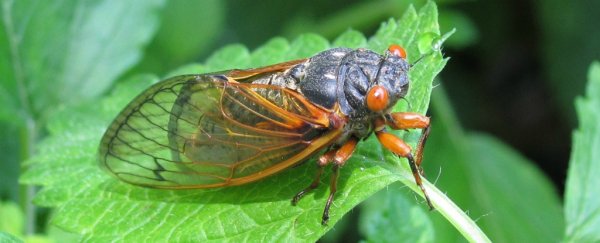Things are about to get real noisy if you live in the northeastern United States. Billions of cicadas are scheduled to burst out of the earth this May, causing a cacophony of humming as they seek out mates for a month-long orgy of sex and death. And who can blame them? They've been waiting for this since 1999.
While some cicada species serenade us each summer, there are three species currently getting ready to erupt into the above-ground world, known as '17-year-cicadas', or 'periodical cicadas'. And, as you might have guessed, they get their name from their unusual regular 17-year life cycle - the longest confirmed life cycle of any insect.
This year, these 17-year-cicadas are about to appear in force in parts of New York, Pennsylvania, Maryland, Virginia, West Virginia, and Ohio - with the insects getting so intense, their density can hit 1.5 million cicadas per acre. (WTF!)
We can't predict the exact date the cicadas will emerge, but it happens whenever the night-time soil temperature hits 64 degrees Fahrenheit (17 degrees Celsius) for four nights in a row at a depth of 8 inches (20.32 cm), to be precise.
And once that happens, things are going to get loud. For the past 17 years, the cicada nymphs have been living underground, slowly growing as they feed on saps sucked out of tree roots.
When they emerge from the soil, they'll climb into trees for shelter and shed their exoskeleton, slowly acquiring a shiny black and orange shell. And then the males will start their whistle-y, hum-like mating chorus (which some people have described as "an alien spaceship coming in").
For the next month, or month and a half, the male cicadas will do pretty much nothing but mate, sing, and eventually die. The silent females will lay eggs, and once they hatch, the nymphs will crawl back into the ground to wait patiently for another 17 years.
"If those males don't mate, they've utterly failed," David Marshall, an entomologist from the University of Connecticut told the Washington Post back in 2004. "So everything they're doing is centred around that sound." Aw.
While the brood that's emerging this year are 17-year cicadas, other periodic cicada species out there have a 13-year life cycle. And if you're doing the maths at home, you might have realised that both of those numbers are primes, which is a pretty cool coincidence, right? Actually, it's not a coincidence at all.
Turns out that it's all part of a sophisticated strategy to stay alive. As Bec Crew reported for us last year: "Practically everything eats cicadas - including dogs and humans - but because they emerge all at once, all those predators can barely make a dent in the total population."
That makes sense, but why the prime numbers?
As this video from It's Okay To Be Smart explains, in nature, predator populations also move in cycles, and those cycles can shift to match up to their prey. So if the cicadas emerged every 12 years, for example, any predators with a two-, four-, or six-year life cycle could adapt to fit theirs. But with prime numbers, it's much harder:
The good news is that cicadas aren't really a threat to our plants (or us) at all.
So if you happen to walk into the middle of a whole bunch of humming in your backyard next month, don't freak out, don't make it weird. Just enjoy the hornbag sounds of summer.
After all, these guys and girls have been waiting very patiently - and very strategically - since 1999 for this. Let's let them enjoy it.
TFW the soothing sounds of nature are really just the sounds of animals trying to get laid… https://t.co/aj1Y0mzAQb pic.twitter.com/i3zWaaqDTx
— ScienceAlert (@ScienceAlert) March 3, 2016
